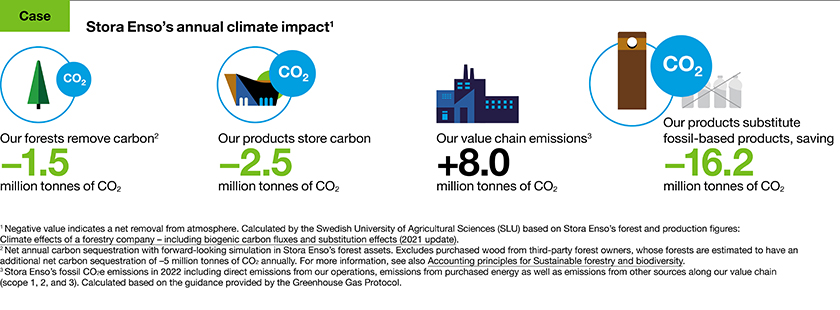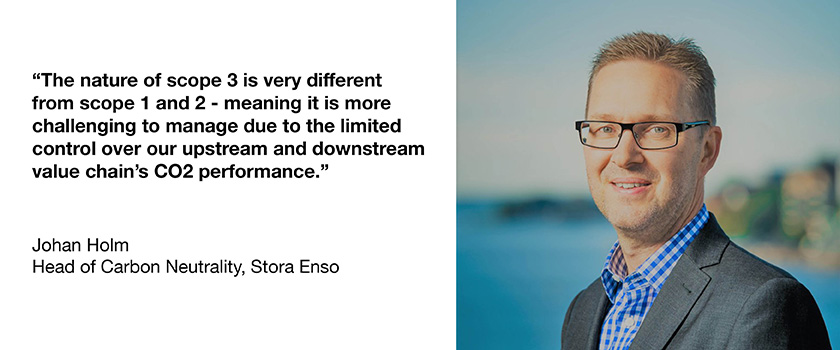Stora Enso's role in combatting climate change is elaborate
"Forests store carbon, and so do products made from trees, during their lifetime," Johan Holm explains. "When renewable materials replace fossil-based alternatives, it has a positive substitution effect, which, at scale, can impact societies at large. In addition, we work actively to reduce our own emissions by reducing the use of fossil fuels, improving the energy efficiency of production processes, and increasing the share of clean energy sources, including biomass fuels from sustainable sources. In addition to our own direct and indirect emissions, our climate targets cover the entire value chain.”
In terms of reducing Stora Enso's own emissions in 2022, we made significant progress towards our science-based targets for 2030 for scope 1 and 2 emissions. In 2022, we decreased our emissions by 27% compared to the 2019 baseline year. "We have implemented energy efficiency measures, increased the share of renewable energy in our portfolio to 85%, and decreased our use of fossil fuels," Johan notes. "As part of our roadmap for reaching the 2030 target for scope 1 and 2, we have made investments such as the replacement of fossil-based heavy fuel oil with renewable pitch oil at our Enocell pulp mill in Finland.”
Tackling scope 3 emissions
Scope 3 emissions, meaning emissions not controlled or owned by us, presents challenges in managing – but opportunities for pivotal impact across the value chain. Scope 3 often represents most of the organisation's total value chain emissions, and this is the case at Stora Enso too, where scope 3 emissions make up more than 75% of the total emissions. The majority of these emissions are generated during the sourcing and manufacturing of raw materials, further processing of products by customers, and in the transportation of raw materials and final products.
“The nature of scope 3 is very different from scope 1 and 2 - meaning it is more challenging to manage due to the limited control over our upstream and downstream value chain’s CO2 performance. Without the ability to effectively manage this aspect, it is challenging to carry out data-driven actions and investments. In the future, we need to be able to handle the scope 3 data just like any other financial data,” Johan explains. “Additionally, carbon reduction actions or low carbon materials should be considered as equally relevant aspects as, for example quality or price when choosing raw materials,” Johan adds.
Johan has over 30 years of experience in sustainability, making him a subject matter expert in carbon, mastering corporate carbon accounting including the GHG protocol. He is also well versed with the work by IPCC and has been involved in the process for WBCSDs TCFD preparer forum for Food, Agriculture and Forest Products. Johan holds an Msc. in Civil Engineering from the University of Utah.
Stora Enso acknowledges that to meet the 1.5-degree scenario, ambitious action is needed, and has therefore set a science-based target for scope 3, aiming for a 50% reduction from the 2019 baseline by 2030. Johan continues; “We systematically engage with suppliers; Stora Enso requires suppliers to provide data on their CO2 performance as part of its tendering process and encourages suppliers to set their own targets for reducing emissions. One example of our collaboration is the Supplier Day we arranged for our key suppliers, to share best practices on actions to reduce CO2e emissions and promote the move towards science-based targets.”
What the future holds
Looking forward, Johan identifies three trending topics that are becoming increasingly important in the fight against climate change. “Firstly, companies need to transform from only minimising negative impacts to maximising the positive. The discussion around climate action has now started to cover avoided emissions, meaning emission reductions that occur outside a company’s value chain but can be considered a result of the company’s product. Though we do not yet have a common accounting standard for avoided emissions, this, too, will likely be evolving rapidly as consumers expect more data for decision-making and organisations are looking for ways to quantify their broader impact” Johan says. "Secondly, there is and will be greater pressure on transparency and disclosure. The evolving Carbon Removals and Land Sector Initiative by GHG Protocol, and EU’s Corporate Sustainability Reporting Directive, for example, will have a central role in guiding climate action in our industry. With more stringent regulation and new frameworks, we will hopefully see more common standards on reporting scope 3 and thereby improving the comparability of this data. The discussions, and strong business presence at COP27, goes to show that the demand for regulation is more prominent than ever. Lastly, once the regulations are in place – the real key is to collaborate.”







